By Pete Vack
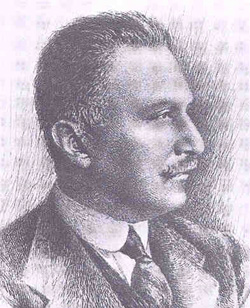
Fiat's founding father, Giovanni Agnelli, was Gianni's grandfather.
Gianni's father Edoardo died in an airplane accident.
|
On January 24th,2003, 81 year old Giovanni "Gianni" Agnelli passed away at his home in Turin. His death marked the end of an era in many ways, and with the very future of the 104 year-old company in doubt, we thought it might be appropriate to look back at what Fiat has created in terms of interesting, great and near-great Italian automobiles.
Since its inception in 1899, Fiat has had only three CEOs; Giovanni Agnelli, the founder and grandfather of Gianni who headed the firm from 1899 to his death in 1945; Professor Vittorio Valletta, a severe but highly successful businessman who presided over Fiat from 1945 to 1966; and finally, Giovanni Agnelli, who succeeded Valletta. (In 1980, after years of labor unrest and dealing with the "Red Brigades", Agnelli no longer served as an active manager, but gave the top post to Cesare Romiti, who in turn was succeeded in 1998 by Paolo Fresco, who in turn was recently replaced
by Umberto Agnelli, Gianni's younger brother.)
The Fiats of Giovanni Agnelli, 1899-1945
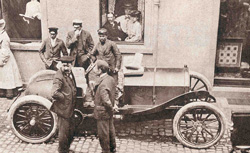
Five years after the beginnings of the firm, Fiat was already racing and winning in international events both in Europe and America. the 75 HP Corsa was entered in the 1904 Gordon Bennett Cup races, a precursor to Grand Prix racing.
|
Today's classic car enthusiast tends to focus on cars of the post WWII era, but
when looking back at the Veteran era, one finds fascinating designs and unusual ideas, some well ahead of their times. These advanced features appeared first on the rcing cars of the times.
For Fiat, racing was essential to the rapid development of the automobile.
Fiat�s participation in racing began almost immediately. In 1900, the 6HP Corsa, based on the production model, won the Turin-Asti race and driven by Vincenzo Lancia, also won the Vicenza-Padua race. The 6 HP Corsa was a twin of about one liter and produced 10 horsepower. By 1902, using an inline four(two twins) of 40 hp, the 24 HP Corsa won several important hillclimbs, again with Lancia at the wheel. Making its debut in the 1903 Targa Florio, the 60 Hp, with a top speed of 75 mph, won its class, but still competitive in 1911, it won the French Grand Prix. Now with overhead valves and pressurized lubrication, the 75 Hp of 1904 was also successful in the hands of Vincenzo Lancia.
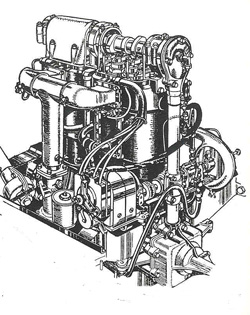
The S.61 Corsa engine, with a SOHC driven by bevel gears, and four valves
per cylinder. The 10 plus liters produced about 115 hp.
|
1900-1918 Nothing succeeds like cubic centimeters
Displacements of these early cars were enormous. While the first cars featured two cylinder one liter engines, by 1904 the four cylinder race cars were well over 14 liters, and the Gordon Bennett entry of 1905 was capable of 100 mph with a capacity of 16,286 cc.
The age of dinosaur displacements culminated in the 1911 S.76 Corsa, which employed a four cylinder 28 liter automotive engine to attempt a land speed record. In the meantime, a series of racecars with somewhat lesser displacements continued to win races. The S.61 Corsa, a 10 liter four with four overhead valves per cylinder and bevel camshaft drive placed third in the first Indianapolis 500.
In 1911 the S.74 Corsa produced 190 hp and won the American Grand Prix at Savanah driven by David Bruce-Brown. Fiat was already on the world map, growing, successful, and highly respected. For the rich and famous, Fiat produced a wild array of touring cars from the 1 liter twins to ten liter phaetons and everything in-between in both four and six cylinder inline configurations. As veteran and vintage antiques, early road going Fiats are both rare and valuable, while any racing Fiat of those years is not only a prime collectable, but virtually impossible to find.
1918-1931 High Tech, Low Displacement
World War I brought about significant improvements in both metallurgy and design. The advent of the double overhead cam engine, essentially the same form it exists today, substantial improvements in both carburetion and supercharging, meant that racing engine displacements decreased while the horsepower increased. Having accumulated a large degree of experience during the war, Fiat applied the new technologies to competition cars. Nomenclature was also less confusing; most of the road Fiats from 1919 to 1940 were designated from 501 to 527, while the single seater race cars were all 800 series cars. The exceptions were the 1500, 1100 and 2800 of the 1930s.
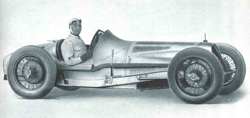
The ultimate Fiat race car, the 12 cylinder 806 of 1927. Pietro Bordino sits in the last Grand Prix Fiat.
|
Of the race cars, one, the S57A, was a pre-war car designed for that year�s Indianapolis, but did not compete until 1921, when it won the Targa Florio.
That same year saw the first of the 800 series, true Grand Prix cars which began with the 801-401, using a four cylinder 3 liter DOHC engine which developed 112 hp. Also in 1921, the 801-402 saw competition, with a 3 liter eight cyliner DOHC. For the Voiturrette class (think Formula II) of 1922, Fiat created the 803-403, a four cylinder 1500cc DOHC which took the first four places at Monza that year. The Grand Prix car for 1922 was the 804-404, a 2 liter six which won the French and Italian Grand Prix.
For 1923, Fiat introduced the first supercharged Grand Prix car, dubbed the 805-405, which promptly won the European and Italian Grand Prix.
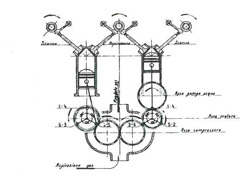
The 806 engine was a 1500cc, supercharged unit consisting of two sixes inline, with two crankshafts and a common
output to the rear wheels.
|
But the crown jewel of all Fiat Grand Prix cars was the last, the 806 of 1927. The formula was for 1500cc supercharged engines, and Fiat came up with a H-12, consisting of two six cylinder engines, each with it�s own crankshaft, and three overhead cams. With 187 hp on tap, it easily won the Grand Prix of Milan. But it was also the last Grand Prix race Fiat would ever enter under it�s name, as they pulled out of racing shortly after the event. It was a high water mark for Fiat.
Trickle Down Theory
The technology was also applied to a new breed of post war Fiats. The 501, an enormously successful 1500cc model, was given a DOHC for sport use, but most of the standard Fiats still employed side valve engines. Many of the models, including the 501, 510, and the luxury 519 were also made with S or "sport" specifications, and were sports cars in every sense of the word. For the luxury market, Fiat created the 520 "Super Fiat". Perhaps five of theses were built during 1921, and featured a V-12 of 6.8 liters. With a 12 ft 7 inch wheelbase, they were intended to compete with the likes of Isotta and Hispano Suiza.
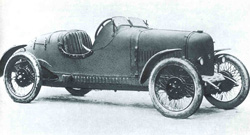
Afte WWI, Fiat began to make "S" versions of their production sedans. The 509 S was not only a sports car, but in sedan form, the first Fiat small car designed for mass consumption.
|
On the other side of the coin, the 509 was introduced in 1925, with a displacement of only 990 cc, it produced 22 hp. It was the first Fiat designed specifically for less wealthy consumers. The age of the small car was about to begin.



